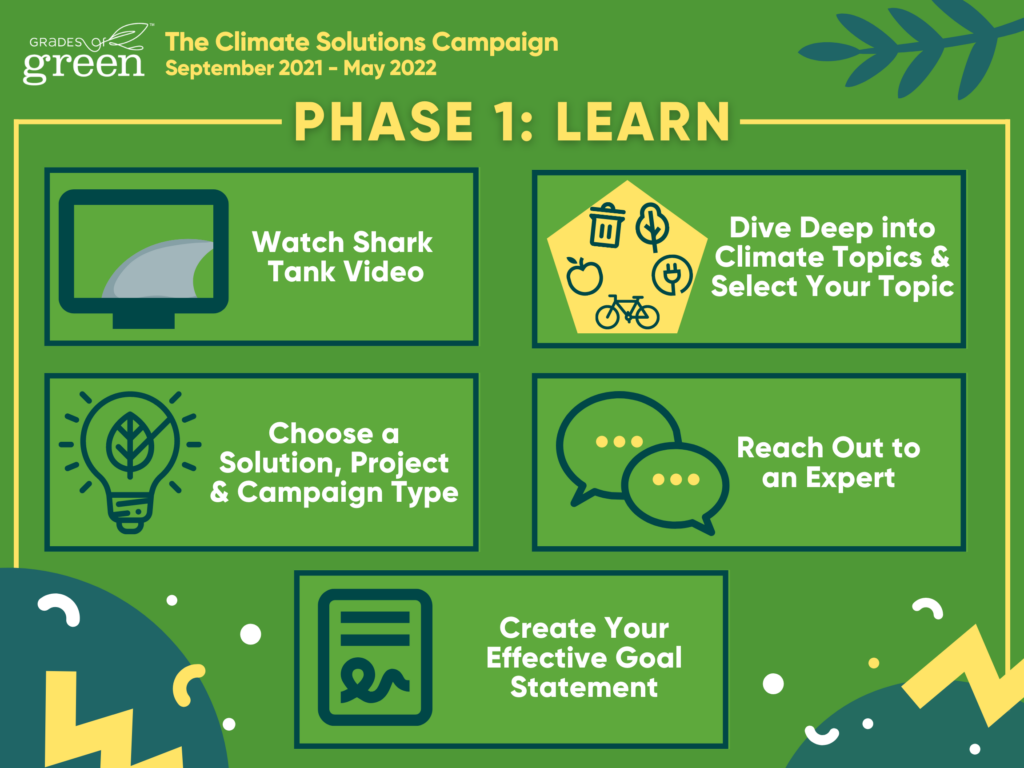It’s time to learn about the Climate Crisis! In Phase 1, your team will explore the 5 key topic areas that contribute to climate change and choose one that you and your team are excited to work on. Next, you’ll select a solution to focus on, a project to make it happen, and a type of campaign to guide your project going forward! You’ll also contact a topic expert(s) to learn how your solution is relevant to your audience or your community and finally establish a goal for your project.
The Campaign Path: Phase 1

Phase 1 – Learn | Check List
- Watch the Climate Crisis Recap video (Earn a Bonus Point)
- ✅ Watch the Climate Solutions Shark Tank Topic video.
- ✅ Explore the Deep Dive on one or more topics.
- Energy, Transportation, Food, Waste, and Trees
- ✅ Decide which topic to focus on for your project. Complete the “Phase 1.1 – Climate Solutions Topic” questions.
- ✅ Choose your team’s solution and project. Complete the “Phase 1.2 – Solution and Project” questions.
- ✅ Pick a campaign type for your project. Complete the “Phase 1.3 – Campaign Types” questions.
- ✅ Reach out to an expert to learn how your topic and project impact your community. Complete the “Phase 1.4 – Reach Out to an Expert” questions.
- ✅ Write an effective goal statement to guide your project. Complete the “Phase 1.5 – Effective Goal Statement” questions.
- Check in with your Advisor.
The Climate Crisis: What’s at Stake*
Before we get started, let’s go over a quick recap of the Climate Crisis: what it is, what causes it and who it impacts the most.
*Watch this video to earn a bonus point!
Get “Pitched” Five Climate Solutions Topics
Welcome to the Climate Solutions Shark Tank! In this video, you’re the “Sharks” who will be pitched five Climate Solution Topics that you can choose from for your project. Click below to start the episode.
Ok Sharks…
You’ve heard from our five environmentalists. Which climate Solutions Topic has ignited your passion and convinced you to learn more? Think about their arguments, review the following summaries, deep dives, and possible project ideas, and then complete the ”Phase 1.1 – Climate Solutions Topic” questions below!
Climate Solutions Topic Summaries
Check out the summaries below of each of the five different Climate Solutions Topics outlined in the Shark Tank video. Skip to the ones you’re most interested in by clicking one of the topics below or explore all five!
Climate Solutions Topic: ENERGY
Interested in climate solutions related to Energy? Great! Read the summary below to learn more and click to open the Deep Dive to get all the details.

Key Concepts
- Energy production is one of the largest sources of greenhouse gases.
- Most energy is currently produced by the direct burning of fossil fuels: coal, oil, and natural gas.
- Fossil fuel production unfairly impacts low-income communities and communities of black, indigenous, and people of color where the residents are exposed to higher rates of pollution and toxins.
- We can reduce energy related greenhouse gas emissions by calling for renewable energy, making buildings more energy efficient, and conserving water.
Key Stats
- Buildings use 36% of all the energy that is generated each year. (UN Environment Global Status Report 2017)
- Every year the U.S. uses enough water to fill 88 MILLION Olympic-size swimming pools to generate energy! It also takes A LOT of energy to pump, treat and move water. Saving water saves energy. (Energy and Water).
- 80% of the greenhouse gases driving the climate crisis are the result of burning fossil fuels, and most is burned to produce energy. (EESI Fossil Fuels).
Solutions
- Advocate for the Transition to 100% Renewable Energy
- Increase Energy Efficiency
- Save Water to Save Energy
Click here to find a list of sample project ideas related to energy.
Next Step: Read the Energy Deep Dive
The next step is to learn more about Energy issues in our Energy Deep Dive. There, you can re-watch the Climate Solutions Shark Tank Pitch and find a treasure chest of statistics and facts to use in your project materials. You’ll also find a list of project ideas to inspire you!
Climate Solutions Topic: TRANSPORTATION
Interested in climate solutions related to Transportation? Great! Read the summary below to learn more and click to open the Deep Dive to get all the details.

Key Concepts
- Transportation contributes significantly to the steady rise in the earth’s temperature.
- Greenhouse gas emissions from transportation are increasing.
- Transportation systems routinely benefit affluent communities at the expense of low-income communities and communities of black, indigenous and people of color who must bear the burden of the resulting poor air quality and negative health impacts.
- We can reduce transportation-related greenhouse gas emissions by encouraging electric cars and charging stations, organizing carpooling, mass transit, biking and scootering, and new laws.
Key Stats
- The US transportation sector – which includes cars, trucks, planes, trains, and ships – produces nearly 30% of all US global warming emissions (EPA Transportation and Pollution and Climate Change).
- Emissions from transportation are on the rise. Between 1990 and 2018, emissions from transportation – cars, trucks, buses, railroads, planes, ships – increased more than any other sector (Yale Climate Connections Transportation).
- Cars are responsible for about 59% of all transportation-related emissions (EPA Transportation and Pollution and Climate Change).
Solutions
- Reduce Idling Emissions
- Promote Alternative Modes of Transportation
- Promote Electric Vehicles
- Reduce Shopping Miles
Click here to find a list of sample project ideas related to transportation.
Next Step: Read the Transportation Deep Dive
The next step is to learn more about Transportation issues in our Transportation Deep Dive. There, you can re-watch the Climate Solutions Shark Tank Pitch and find a treasure chest of statistics and facts to use in your project materials. You’ll also find a list of project ideas to inspire you!
Climate Solutions Topic: FOOD
Interested in climate solutions related to Food? Great! Read the summary below to learn more and click to open the Deep Dive to get all the details.

Key Concepts
- All activities related to our food system, including production, transportation and managing waste, produce greenhouse gasses and contribute to climate change.
- Plant-based diets lead to a significantly smaller greenhouse gas footprint than meat-based diets.
- Transporting food far distances results in greenhouse gas emissions, so buying in season, local foods is a better choice.
- Farming practices often create conditions that negatively affect the health of workers and nearby low-income communities and communities of black, indigenous and people of color. Communities of color also often have less access to healthy, sustainably-produced foods.
- Wasted food often ends up in landfills where it decomposes and releases the greenhouse gas, methane.
Key Stats
- Food production and processing are responsible for approximately 26% of global greenhouse gas emissions (Our World In Data).
- 40% of all food produced is wasted (Yale Climate Connections).
- About 11% of all the greenhouse gas emissions that come from the food system could be reduced if we stop wasting food (World Wildlife Foundation).
Solutions
- Reduce Meat Consumption
- Promote Tropical-Forest-Friendly Foods
- Promote Sustainably-Produced Foods
- Reduce Food Waste
Click here to find a list of sample project ideas related to food.
Next Step: Read the Food Deep Dive
The next step is to learn more about Food issues in our Food Deep Dive. There, you can re-watch the Climate Solutions Shark Tank Pitch and find a treasure chest of statistics and facts to use in your project materials. You’ll also find a list of project ideas to inspire you!
Climate Solutions Topic: WASTE
Interested in climate solutions related to Waste? Great! Read the summary below to learn more and click to open the Deep Dive to get all the details.

Key Concepts
- The manufacturing, distribution, and use of the goods and food we rely on all require energy that predominantly comes from fossil fuels, which are the largest source of greenhouse gas emissions.
- Waste from our global products eventually needs to be disposed of through recycling, incinerating, or landfills.
- Waste facilities like incinerators, landfills, and waste treatment plants are almost always located in communities of black, indigenous, and people of color whose residents experience the negative health impacts of the resulting increased pollutants and toxins. Each of these three options results in the production and emission of greenhouse gases.
- Using less and reusing what we already have is key to reducing climate change caused by waste.
Key Stats
- 29 percent of US greenhouse gas emissions come from the provision of goods produced within the United States and managing the waste from those goods represents 1 to 5 percent of US greenhouse gas emissions (US EPA).
- Globally we use about 150 million tons of single-use plastics each year and only about 7 percent of plastic is ever recycled (Columbia.edu).
- If plastics production and incineration increase as expected, greenhouse gas emissions will increase to 49 million metric tons by 2030 and 91 million metric tons by 2050 (Yale Climate Connections).
- Methane is a greenhouse gas that is up to 25 times as potent as carbon dioxide and is a driver of climate change. Landfills are the United States’ third largest source of methane emissions (climatecentral.org).
Solutions
- Reduce Single-Use Plastics and Promote Reusable Items
- Reduce Litter
- Reduce Clothing/Textile Waste
- Reduce Electronic Waste
- Promote Reuse
Click here to find a list of sample project ideas related to waste.
Next Step: Read the Waste Deep Dive
The next step is to learn more about Waste issues in our Waste Deep Dive. There, you can re-watch the Climate Solutions Shark Tank Pitch and find a treasure chest of statistics and facts to use in your project materials. You’ll also find a list of project ideas to inspire you!
Climate Solutions Topic: TREES
Interested in climate solutions related to Trees and Deforestation? Great! Read the summary below to learn more and click to open the Deep Dive to get all the details.

Key Concepts
- Trees store carbon and release stored carbon when they are cut down and processed.
- Forests the size of a football field are cut down every second. (Yale Environment 360).
- Deforestation occurs in underdeveloped areas to produce products that are consumed by the developed world.
- Heat Islands are commonly found in low-income communities and communities of black, indigenous, and people of color, where residents have the least access to resources for keeping cool and healthy.
- Forest preservation and restoration could potentially capture as much as 1/3 of the greenhouse gases we need to remove from the atmosphere by 2030 to keep the earth’s temperature rise to 1.5C (Intergovernmental Panel on Climate Change).
- We can reduce deforestation related greenhouse gas emissions by supporting preservation and reforestation programs, planting trees, and committing to purchasing sustainable products.
Key Stats
- Only about 30% of world’s forests are still standing today. (National Geographic)
- Since 2016, we’ve cut down about a football field of forest EVERY SINGLE SECOND, and at this rate it is estimated the world’s rainforests will be gone in 100 years. (The World Counts).
- Deforestation currently accounts for about 20% of the world’s annual greenhouse gas emissions and unless we protect and restore forests, deforestation is projected to increase up to 80% by the year 2100 (GlobalChange.gov)
Solutions
- Increase Urban Tree Cover
- Protect Tropical and Old Growth Forests
- Combat the Urban Heat Island Effect
Next Step: Read the Tree Deep Dive
The next step is to learn more about Trees and Deforestation issues in our Trees Deep Dive. There, you can re-watch the Climate Solutions Shark Tank Pitch and find a treasure chest of statistics and facts to use in your project materials. You’ll also find a list of project ideas to inspire you!
Climate Solutions Topic Deep Dives
It’s time to dig a little deeper! Click on a topic or two (or all!) to learn more about that topic. Once you’ve explored the Deep Dive, your team is ready to choose the topic that you’ll focus on when developing your Climate Solution. Remember, you can always come back to this page to check out the other topics at any time.
Having trouble viewing or completing the form below? To view in Google Forms click here – Phase 1.1 Form
NEXT STEP: Pick Your Team’s Solution and Project
Click Here: Phase 1.2 Pick Your Solution and Project
Looking for Another Page? Head over to the Campaign’s Table of Contents.